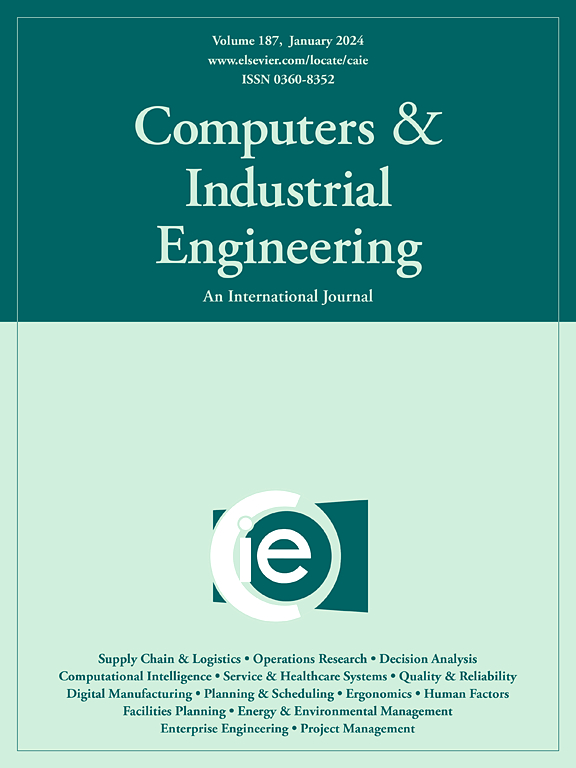基于高风险区域识别和SA-APSO的海上SAR装备联合多目标优化部署
IF 6.7
1区 工程技术
Q1 COMPUTER SCIENCE, INTERDISCIPLINARY APPLICATIONS
引用次数: 0
摘要
搜救设备的预定位是快速有效应对海上突发事件的一种实用方法。在本研究中,我们提出了一种综合方法来优化SAR设备(LCSRE)的位置和配置,这是应急响应效率的关键决定因素。首先,我们使用随机森林(RF)模型根据海上事故数据和自动识别系统(AIS)数据识别高风险子区域,为LCSRE决策提供数据驱动基础。其次,采用模糊综合评价法(FCEM)计算候选站点外部干扰因素的综合影响指数,量化候选站点的适宜性。最后,考虑到岛屿的支持作用,我们开发了一个模型,旨在最大限度地减少响应时间和总体配置成本,同时提高服务覆盖率。为了求解该模型,我们提出了一种模拟退火增强自适应粒子群优化(SA-APSO)算法。数值实验表明,与单船策略相比,该方法平均成本降低了69.2%,覆盖范围提高了30.1%。此外,通过将高风险分区识别整合到多模式部署规划中,相对于风险中性的多模式基线,该方法进一步降低了总成本3.49%-18.36%,并将覆盖范围提高了5.23%-11.33%。与2024年实际配置方案相比,优化后的方案覆盖率由85.47%提高到95.41%,总成本降低11.63%。这些结果表明了该方法在海上SAR规划中的实用价值和鲁棒性。本文章由计算机程序翻译,如有差异,请以英文原文为准。
Joint multi-objective optimization of maritime SAR equipment deployment using high-risk area recognition and SA-APSO
Pre-positioning of search and rescue (SAR) equipment is a practical approach for rapidly and effectively responding to maritime emergencies. In this study, we present a comprehensive method to optimize the location and configuration of SAR equipment (LCSRE), which are critical determinants of emergency response efficiency. First, we use a random forest (RF) model to identify high-risk subareas based on maritime accident data and Automatic Identification System (AIS) data, providing a data-driven foundation for informed LCSRE decisions. Next, the Fuzzy Comprehensive Evaluation Method (FCEM) is employed to calculate a comprehensive impact index for external interference factors at candidate sites, quantifying their suitability. Finally, considering the supportive role of islands, we develop a model aimed at minimizing response times and overall configuration costs while improving service coverage. To solve the model, we propose a Simulated Annealing-enhanced Adaptive Particle Swarm Optimization (SA-APSO) algorithm. The numerical experiments demonstrate that the proposed method achieves an average cost reduction of 69.2% and a coverage improvement of 30.1% compared to the ship-only strategy. Moreover, by integrating the high-risk subarea recognition into multimodal deployment planning, it further reduces total cost by an additional 3.49%–18.36% and increases coverage by 5.23%–11.33% relative to a risk-neutral multimodal baseline. Compare to the actual 2024 configuration plan, the optimized solution increases coverage from 85.47% to 95.41% and reduces total cost by 11.63%. These results demonstrate the practical value and robustness of the proposed method for maritime SAR planning.
求助全文
通过发布文献求助,成功后即可免费获取论文全文。
去求助
来源期刊

Computers & Industrial Engineering
工程技术-工程:工业
CiteScore
12.70
自引率
12.70%
发文量
794
审稿时长
10.6 months
期刊介绍:
Computers & Industrial Engineering (CAIE) is dedicated to researchers, educators, and practitioners in industrial engineering and related fields. Pioneering the integration of computers in research, education, and practice, industrial engineering has evolved to make computers and electronic communication integral to its domain. CAIE publishes original contributions focusing on the development of novel computerized methodologies to address industrial engineering problems. It also highlights the applications of these methodologies to issues within the broader industrial engineering and associated communities. The journal actively encourages submissions that push the boundaries of fundamental theories and concepts in industrial engineering techniques.
 求助内容:
求助内容: 应助结果提醒方式:
应助结果提醒方式:


